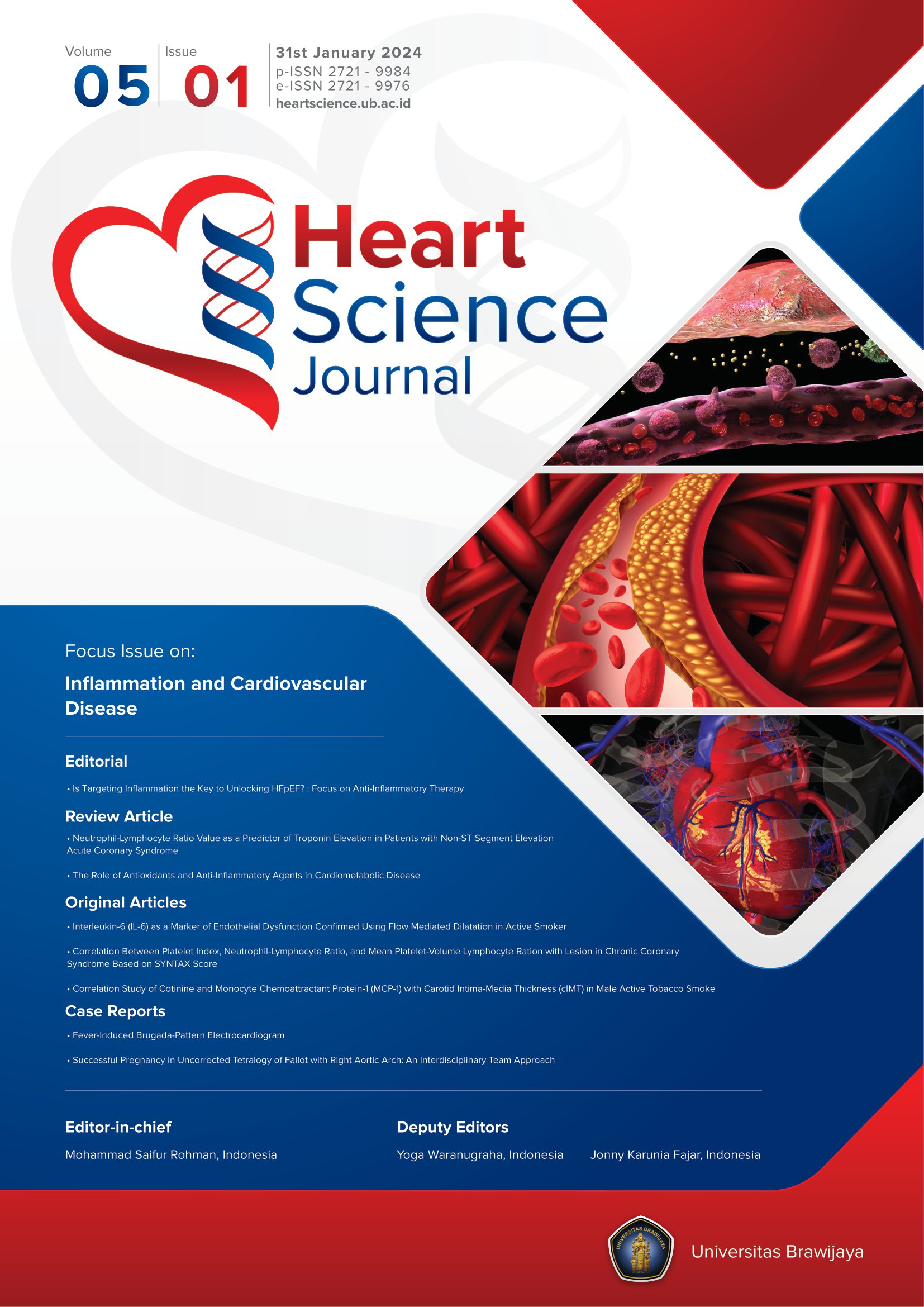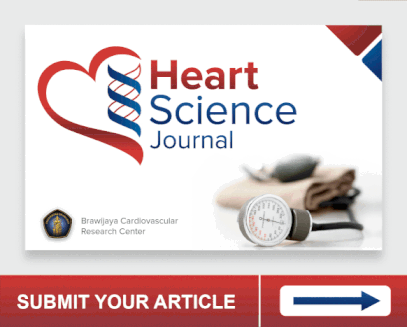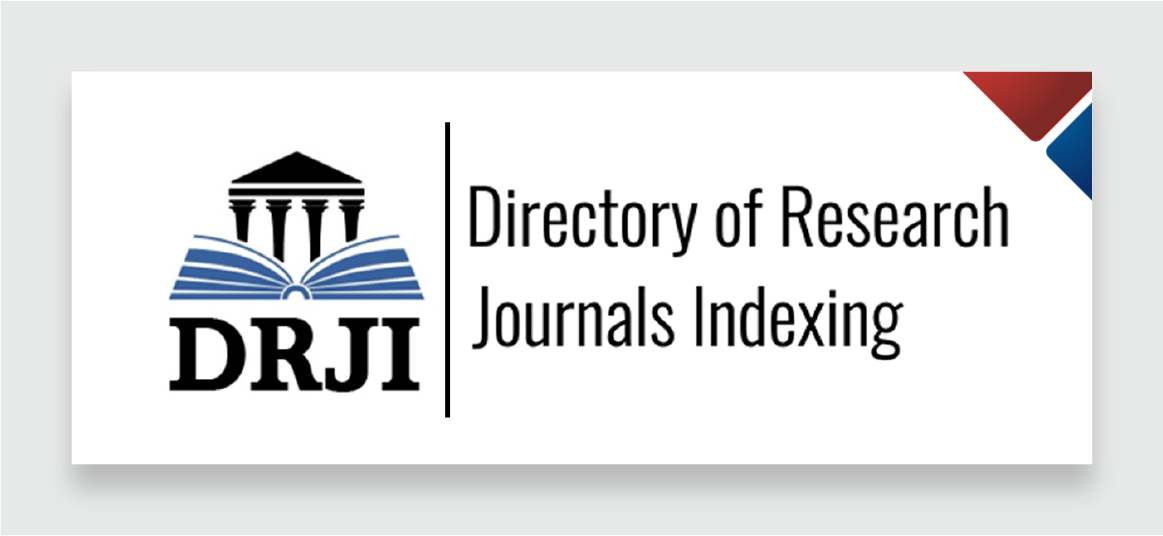The Role of STEMI Communication Network in Malang with Major Adverse Cardiac Event (MACE) Incidence in STEMI Patients Hospitalized in Saiful Anwar General Hospital Malang
Abstract
Background: Patient with STEMI requires urgent reperfusion either with fibrinolytic or primary PCI. In Malang, a communication network of STEMI has been developed. It connects Saiful Anwar General Hospital with all of the PHC in Greater Malang to shorten system delay since 2015.
Objective: To elucidate Malang’s communication network’s role in decreasing MACE (Major Adverse Cardiac Event) in STEMI patients.
Methods : This is a retrospective cohort study. Study sample was taken from medical record. Non-network: 96 patients and 88 network patients. Statistical tests using SPSS and PLS, α value 0.05 and t-test is significant if more than 1.96.
Results: Bivariate analysis shows network-group has a significantly lower MACE (p=0.001). Door-to-balloon time is also lower in network-group (p=0.026). Multivariate analysis without confounder shows that network-group has significantly shorter door-to-reperfusion time (p=0.032) and lower MACE (p=0.035) compared to non-network group. But multivariate analysis with confounder door-to-balloon and door-to-needle fails to explain lower MACE incidence. Network-group (p=0.005) and reperfusion with primary PCI (p=0.05) significantly decrease MACE incidence.
Conclusion: Malang’s STEMI communication network and reperfusion with primary PCI reduce MACE in STEMI patients in Saiful Anwar General Hospital Malang.
Keywords
Full Text:
PDFReferences
Roger VL, Go AS, Lloyd-Jones DM, Benjamin EJ, Berry JD, Borden WB, Bravata DM, Dai S, Ford ES, Fox CS, Fullerton HJ. Heart disease and stroke statistics--2012 update: a report from the American Heart Association. Circulation. 2012 Jan;125(1):e2-20.
Penelitian B. Riset kesehatan dasar (Riskesdas) 2013. Lap Nas. 2013;2013(1):384.
Deopujari, R., Dixit, A. The Study of Age Related Changes in Coronary Arteries and its Relevance to the Atherosclerosis. J Anat Soc India, 2010 59(2):192-196
Soliman EZ, Lopez F, O’Neal WT, Chen LY, Bengtson L, Zhang ZM, Loehr L, Cushman M, Alonso A. Atrial fibrillation and risk of ST-segment–elevation versus non–ST-segment–elevation myocardial infarction: The Atherosclerosis Risk in Communities (ARIC) Study. Circulation. 2015 May 26;131(21):1843-50.
Topol E, Califf R, Prystowsky E, et al. Textbook of Cardiovascular Medicine. 2007; 19:280-303
WHO MONICA Project Principal Investigators. The World Health Organization MONICA Project (monitoring trends and determinants in cardiovascular disease): a major international collaboration. Journal of clinical epidemiology. 1988 Jan 1;41(2):105-14.
Alexander T, Victor SM, Mullasari AS, Veerasekar G, Subramaniam K, Nallamothu BK, TN-STEMI Programme Investigators. Protocol for a prospective, controlled study of assertive and timely reperfusion for patients with ST-segment elevation myocardial infarction in Tamil Nadu: the TN-STEMI programme. BMJ open. 2013 Dec 1;3(12):e003850.
Bonnefoy E, Steg PG, Boutitie F, Dubien PY, Lapostolle F, Roncalli J, Dissait F, Vanzetto G, Leizorowicz A, Kirkorian G, CAPTIM Investigators. Comparison of primary angioplasty and pre-hospital fibrinolysis in acute myocardial infarction (CAPTIM) trial: a 5-year follow-up. European heart journal. 2009 May 8;30(13):1598-606.
DOI: https://doi.org/10.21776/ub.hsj.2021.002.04.3
Refbacks
- There are currently no refbacks.
Copyright (c) 2021 Adhika Prastya Wikananda, Lenny Kartika, Dadang Hendrawan, Heny Martini, Mohammad Saifur Rohman

This work is licensed under a Creative Commons Attribution 4.0 International License.









